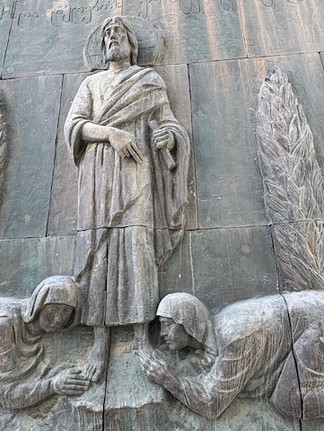At the Edge of Europe: Christianity and Khachapuri
- Ian Rosenberg

- Jul 14
- 7 min read
After five weeks in Central Asia, it was finally time to say goodbye to the plov, the lagman, the yurts, the steppes, and the bustling markets. We were headed to the Caucasus.
Some may argue that this is where my “Asia” trip turns into a “Europe” trip. And sure enough, as soon as we landed in Georgia, there were EU flags around every corner. In fact, I think in my three days in Georgia, I saw more EU flags than I’d seen in all the time I’ve spent in the EU combined. And get this, Georgia isn’t even in the EU! They just have this overwhelming obsession with being European, acting European, and convincing the world that they belong—they’re European.
Tbilisi is exactly how I’d imagine Prague or Budapest. A city completely segregated. There’s the old town, with its beautiful, centuries-old buildings climbing up the hill all the way to the Mother of Georgia statue at the top. Each building with its own character, its own charm, yet still architecturally unified to create this overall rustic and lived-in ambiance. But looking around, all you’ll find is hostels, restaurants offering inflated prices, wine bars with signs only in English, souvenir shops galore, and a seemingly impossible number of currency exchange places. And these exchange places offer such a good rate without any commission that I frankly do not understand how they stay open. Like, Zack and I exchanged $100, and we got $99.67 worth of lari back.
Despite all that, Old Tbilisi is really charming and lovely to be around. Locals do enjoy it, and you’ll hear more Georgian in this area of the city than you may hear Czech in the center of Prague or Polish in the center of Krakow. Because if there’s one thing the Georgians are good at, it’s being proud of being Georgian. It’s loving your history, loving your city, and making sure every tourist knows every dish to ever try and every wine to ever taste.
Anyways, that’s Old Tbilisi. There’s a whole city around it with modern or Soviet-style skyscrapers, Parisian style wide boulevards and buildings, all without the odd, dead-end-filled windiness in Old Tbilisi. In the other areas, you’ll see nearly exclusively Georgian, and sure, wine and restaurants are incredibly easy to come across (because the Georgians love themselves a good, hearty meal), you’ll see restaurants without pictures of every dish on their menu, expecting that you know what an Ojakhuri, Khinkali, or a Megrelian Khachapuri are without needing to look at it.
Georgia is really passionate about two things: its identity and its food. Let’s talk about these in regard to what we did in Tbilisi.
As I said, Tbilisi feels very European. It’s got that charming Eastern European old-town vibe that you’d get in Krakow, Plovdiv, or Dubrovnik, while still managing to feel European in its Soviet-planned modern city. The people there identify with Europe, and if it weren’t for their corrupt, Russian-aligned government, they’d be well on their way to EU membership. They love wine, they love cheese, and they’re Christian. In fact, they’re the third nation to become Christian, after Armenia and Ethiopia. The riverside sprawls with a large, open-air art market, just as you may see on the banks of the Seine.
But the Georgian identity comes with a whole history that, frankly, nobody ever learns about outside of Georgia. The foundational story of Georgia is that they have that land because on the day that God was giving the land to all the people of the world, the Georgians were late. They were too busy partying and drinking wine to show up. When they finally made it, God informed them that all the land of the world had been given away already. Tough luck. But he, being God, had good in his heart. He had planned for the land of Georgia to be his own personal heaven. The place with the most beautiful landscapes, the best soil to grow the best wine, and the most stunning mountains would be his. But he could not leave the Georgians without land. He sacrificed his happiness, he gave his own heaven away, so that the Georgians too could have a land.
The story also goes that the Georgians were converted by Saint Nino, a woman from central Turkey, in the mid 300s. Previously, they were pagan, but Saint Nino came and started spreading her wisdom of Christ, healing the sick and comforting people in need. Her religion was contentious, but one day, when a solar eclipse came, the people thought that the world was ending. Of course, if you had no idea of a solar eclipse, and suddenly, the sun just disappeared in the middle of the day, wouldn’t you see it as some sort of apocalyptic omen? Well, the king prayed to the pagan gods. It did nothing. But as soon as he tried praying to Nino’s god, then the sun returned. This converted the people instantly. From that point onwards, until today, Georgia has remained deeply Christian.
It's a different kind of Christianity that you can’t find anywhere else. First of all, the cross they use is this wilted cross, with the arms bending downwards. This is because Saint Nino’s cross she made to show the Georgians was made of vines. This vine cross became the symbol of Georgian Christianity.

The churches are stone, decorated on the walls with artwork but not painted. They’re dark, and illuminated only by a few holes in the ceiling and the open door. Large structural pillars serve as more wall space for even more artwork to hang. During mass, there is no sitting. Jesus died for the sins of everyone, so you can stand for a few hours as a modest testament to that. After all, your pain is nothing compared to his. Only the priest is allowed to sit in the ceremonial chair in the center of the room. At the back is a barrier, protecting the secretive room where certain rituals (such as turning the wine into the blood of Christ) are performed. It is forbidden for the lay person to see behind this barrier. Only once in their life—on the day of their marriage—may they walk behind and see what this special area looks like.
Monks pray while swinging incense holders roped to chains. It fills the church with a fragrant air that physically continues to remind you that you’re in a holy space. As they do this, they repeat the same few words over and over, meditatively. One of those words has the ejective, popping “ts” sound that is so distinctive of the Georgian language.
No pictures were allowed in the churches, so this is all I have
And that brings me to the language. Georgian is not a language isolate—it has a few sister languages spoken in and around Georgia—but it’s pretty darn close to a language isolate. The Kartvelian languages are a unique branch of languages with some odd features. First is their writing system. The Georgian script is loopy, looking like it belongs somewhere in South or Southeast Asia and certainly not between Russia and Turkey.
For some reason, I found it really easy to learn to read Georgian. Maybe it’s because I was hyperfixated on learning it over my three days in the country, reading every sign and every dish on every menu, but I picked up the 33 letters in just over a day’s time. On the second day, our tour guide was teasing me, asking if I was secretly a Georgian government official who’s evaluating the country’s wine tour scene after I could read the signs. In addition, Georgian has these weird ejective consonants, which involve a quick, explosive puff of air, like one would do while beatboxing. They have ejective p, t, ts, k, and even q, the last of which involves creating a pocket of air between the root of your tongue and your uvula, just to collapse it, creating a duck-like sound. Apparently no tourist the tour guide had ever encountered could make this sound, and she was having fun giving me all these bizarre Georgian words with that weird sound, only for me to be able to pronounce them, as she claims, just like a native.
Samples of Written Georgian
The Georgians are very proud of their language and their alphabet. You’ll see locals with bags with their alphabet on it, souvenir shops sell all kinds of alphabet-related merchandise, and they make sure to write with it everywhere they can.
The second thing that makes a Georgian a Georgian is their love for food and wine. I’ll cover wine a little more in the next post, but for now, I’ll talk about the hearty, heavy, and incredibly unhealthy Georgian food.
At the core of the culinary scene is cheese and bread. They have several kinds of cheeses here, some salty, some even saltier, some sour, and some from other animals besides a cow. When you mix cheese and bread together, you get Khachapuri—the iconic Georgian dish. It’s just cheese bread at its core, but the traditions around it and different methods of preparation make it unique.
There’s several kinds of khachapuri. Most common are Megrelian, Imertian, and Ajarian. Each khachapuri is named for the region from which it came. Megrelian is the most like a cheese bread. It’s almost a pizza, with flat bread covered in cheese. Imertian khachapuri has a layer of melted cheese sandwiched between layers of flaky dough, and my favorite, Ajarian, has a bowl-like shape, where the center is filled with melted cheese, topped by an egg. Regardless of what kind of khachapuri you order, it’s going to be thick and filling.
Left: Ajarian, Right: Megrelian with khinkali and shkmeruli in the background
Some other dishes are shkmeruli (chicken in a garlic cream sauce), ojakhuri (peppers onions and pork all pan fried together), khinkali (soup filled dumplings), and plenty more. But we didn’t have that long in Georgia and didn’t even skim the surface of all that they had. What I can firmly say, though, is that the food is delicious, and everyone should try it at some point.
Otherwise, around Tbilisi, we went to the Chronicles of Georgia—a massive monument with black stone pillars, each depicting scenes from the Bible, important Georgian leaders, and moments from Georgia’s history. We also walked around to a lot of churches around the city, and just enjoyed the amazing nightlife of the city. And by nightlife I don’t mean clubs, but rather, the PG kind of nightlife. We walked around, enjoyed street performances, talked with the friendly locals, and enjoyed the ambiance about the streets of Tbilisi.
Tbilisi is a really pleasant city, and though more expensive than anywhere in Central Asia, it’s certainly much more affordable than a standard European destination. Though I can complain that the old town is touristy, there’s still a decent number of Georgians who will walk around and enjoy, particularly at night. It has certainly more of a local vibe than, say, the Champs Elysées. I’d highly recommend a visit for a vacation that feels European, but may be a little more authentic.
In the next post, I’ll delve into depth about Georgia’s Kakheti region, including its importance to religion and…you guessed it…wine.















































Comments